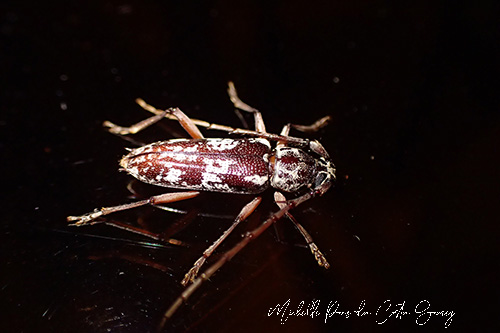On Curaçao, everything that is a beetle, is quite large and does not look like a ladybird is called ‘bakator’ and there are few beetles that have their own name in Papiamentu or even in Papiamento (from Aruba).
This species, the Elaphidion irroratum, does not have it either, although it is not a rare species to encounter on Aruba, Bonaire and Curaçao. In the rainy season, this species of beetle is often attracted to artificial light and will then suddenly sit against the ceiling or on the wall. If you shine a flashlight on it, the body of the animals lights up dark reddish brown with a complicated white pattern on the elytra. It is especially the antennae that are most noticeable because they are so enormously long, one and a half times as long as the body of the beetle itself. The body is no longer than about 2 centimetres, but because of the long slender legs and enormous antennae, the animal looks many times larger. In addition, the antennae look like they have spikes on them, which makes them seem even bigger than they are. When at rest, the antennae are folded along the body, as can be seen in the photo. When the animal is moving and alert, the antennae are raised.
Apart from the name, very little is known about the life of this beetle species, only that its larvae feed on plant tissues such as branches, stems and roots. Many species do this in plants and trees that are already stressed by disease or a fungal infection. The adults can sometimes be found on flowers where they seem to eat nectar and/or pollen.
English name: –
Papiamentu/Papiamento name: bakator
Scientific name: Elaphidion irroratum
Family: Cerambycidae (Longhorn beetle family)
Occurrence (ABC islands): Aruba, Bonaire and Curaçao

Kleine beestjes: Elaphidion irroratum

Op Curaçao wordt alles wat kever is, nogal groot is uitgevallen en niet lijkt op een lieveheersbeestje ‘bakator’ genoemd en er zijn weinig kevers die een eigen naam hebben in het Papiaments op de ABC-eilanden.
Ook deze soort, de Elaphidion irroratum, heeft het niet, al is het geen zeldzame soort om aan te treffen. In de regentijd komt deze keversoort vaak af op kunstmatig licht en zal dan ineens tegen het plafond zitten, of op de muur. Schijn je er met een zaklamp op dan licht het lijf van de dieren donker roodbruin op met een ingewikkeld wit patroon op de dekschilden. Het zijn vooral de voelsprieten die het meest opvallen omdat ze zo enorm lang zijn, wel anderhalf keer zo lang als het lijf van de kever zelf. Die is namelijk niet langer dan een centimeter of 2, maar door de lange slanke poten en enorme voelsprieten ziet het dier er vele malen groter uit. Daarnaast zien de antennes eruit alsof er stekels aanzitten waardoor ze nog groter lijken dan ze zijn. In rust zijn de antennes langs het lijf gevouwen zoals op de foto te zien is. Is het dier in beweging en alert dan worden de voelsprieten omhoog gezet.
Behalve de naam is er heel weinig bekend over de levenswijze van deze keversoort, alleen dat de larven ervan zich voeden met weefsels van planten zoals takken, stengels en wortels. Veel soorten doen dat in planten en bomen die reeds gestrestst zijn door ziekte of een schimmelinfectie. De volwassen dieren zijn weleens te vinden op bloemen waar ze lijken te eten van nectar en of stuifmeel.
Nederlandse naam: –
Papiamentse naam: Bakator
Wetenschappelijke naam: Elaphidion irroratum
Familie: Cerambycidae (Boktorren)
Voorkomen (ABC eilanden): Aruba, Bonaire en Curaçao